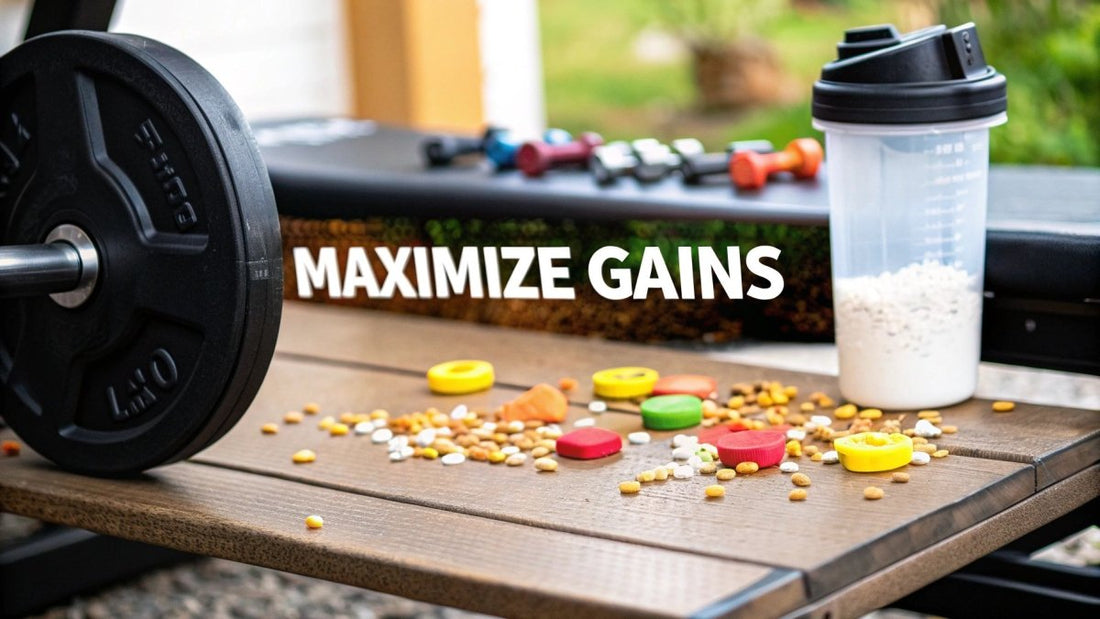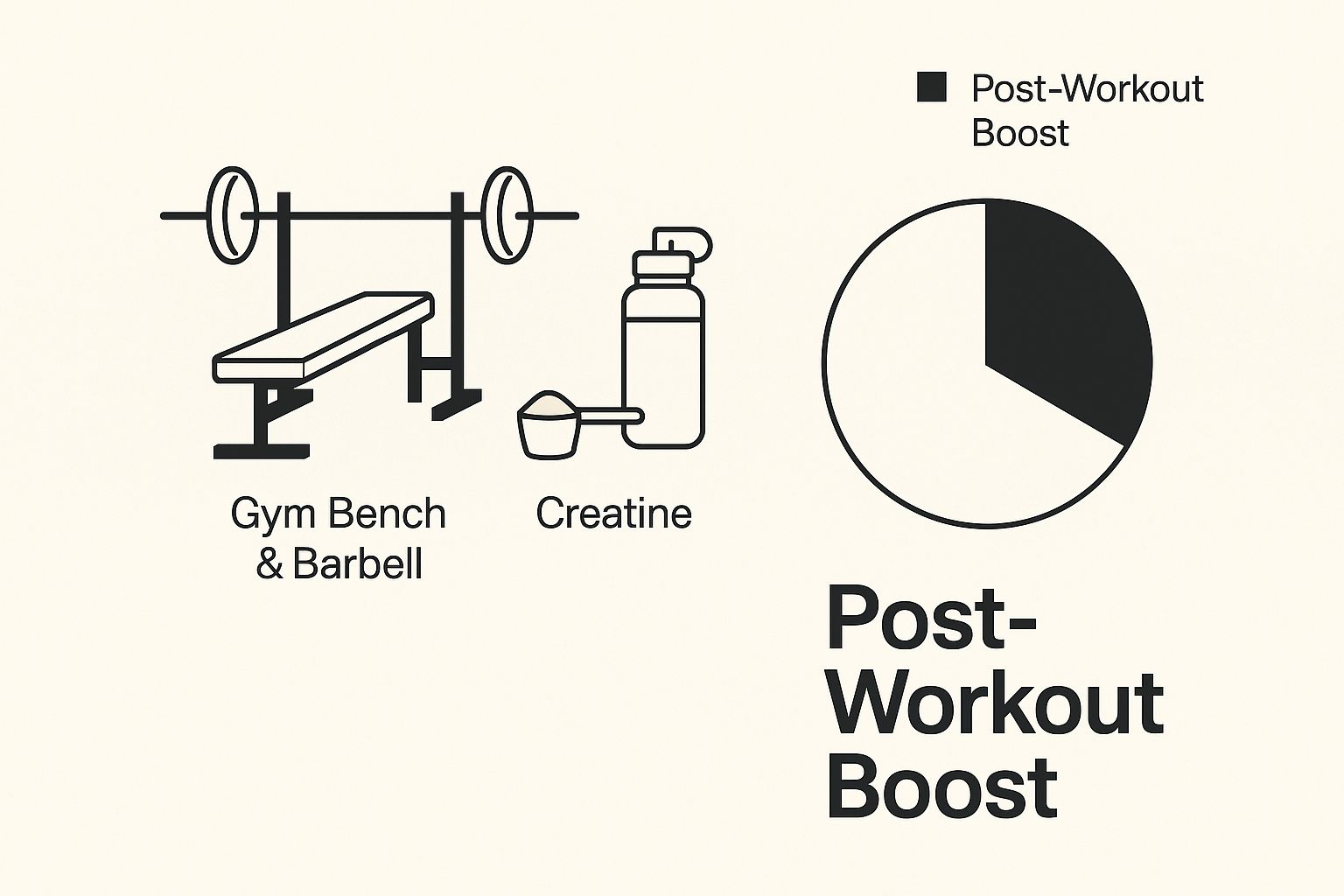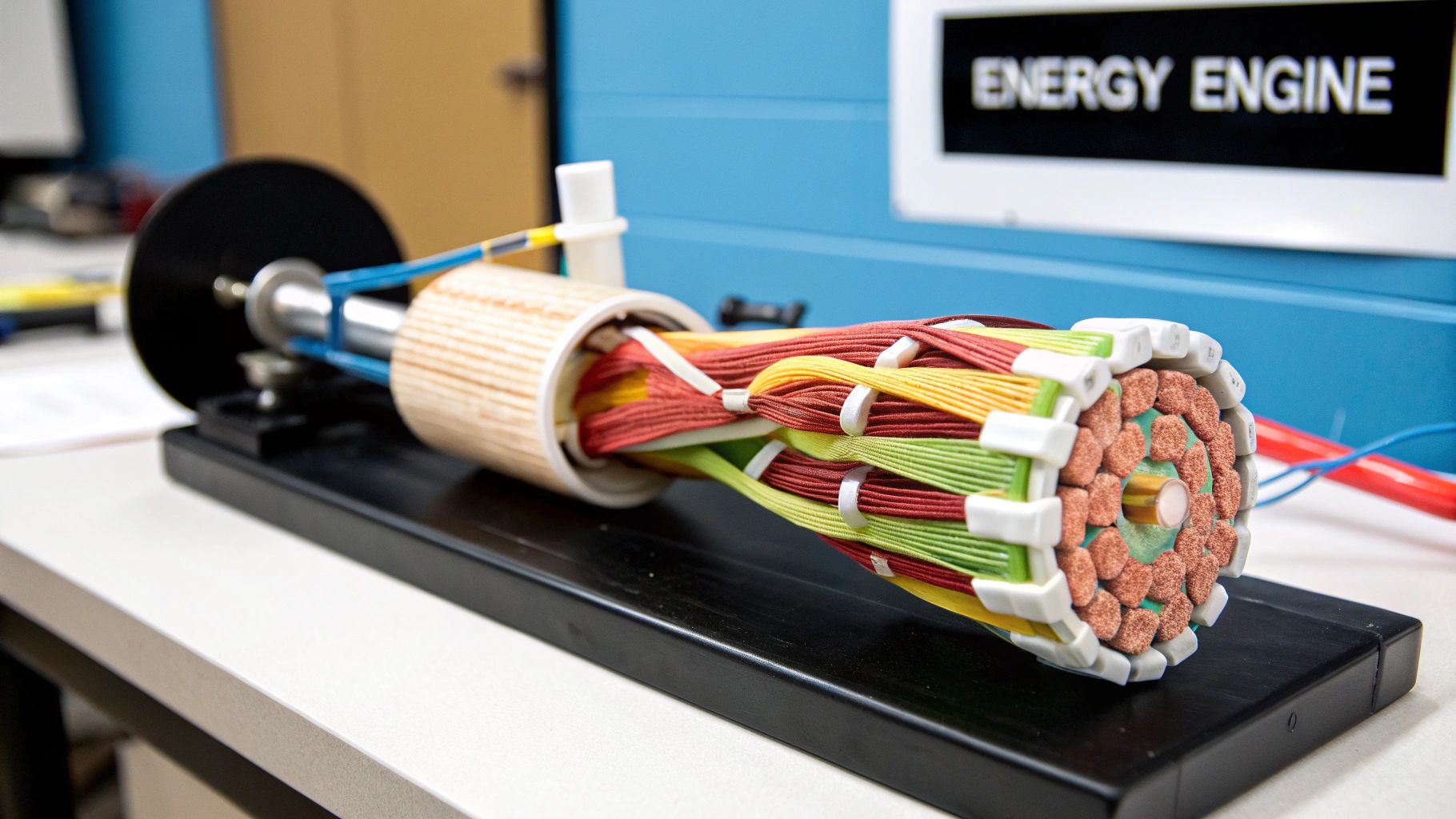
Creatine Before or After Workout: Maximize Your Gains
Share
So, you're wondering about the best time to take your creatine—before or after your workout? The truth is, it's a bit nuanced. While consistency is absolutely the most critical factor, there's growing evidence that post-workout timing might give you a slight edge.
The goal is to keep your muscles fully saturated with creatine, which means that 3-5 gram daily dose is your top priority. But if you want to optimize every last detail, timing it around your workout can make a difference.
The Creatine Timing Verdict: A Quick Guide
Let's get straight to it. Taking creatine before your workout is all about immediate performance. The thinking here is that you're topping off your muscles' energy stores (ATP) right when you need them for those heavy, explosive sets. It’s like filling up your gas tank right before a big race.
On the other hand, the argument for taking it after your workout centers on recovery and absorption. Post-exercise, your muscles are primed for nutrient uptake. Blood flow is high, and your cells are more sensitive to insulin, creating a perfect window to shuttle creatine into your muscles where it can get to work on repair and growth.
This is where the post-workout strategy really shines, focusing on that crucial recovery phase.

As you can see, that post-workout window is a fantastic opportunity to maximize how your body uses nutrients to bounce back stronger. If you want to dive deeper into the science behind this, our complete guide on when to take creatine for best results covers all the details.
Pre-Workout vs Post-Workout At a Glance
To make it even clearer, let's break down the core arguments for each approach. This table gives you a quick, at-a-glance summary of why you might choose one time over the other.
Comparison of Pre-Workout vs Post-Workout Creatine
| Timing Factor | Pre-Workout Rationale | Post-Workout Rationale | Key Outcome |
|---|---|---|---|
| Primary Goal | Immediate Performance Fuel | Enhanced Recovery & Absorption | Long-Term Gains |
| Mechanism | Tops off ATP energy stores for the upcoming session. | Capitalizes on increased blood flow and insulin sensitivity. | Better Nutrient Uptake |
| Psychological Edge | Creates a "ready-to-perform" mindset before training. | Aligns with the natural post-workout recovery ritual. | Habit Formation |
| Best For | Athletes seeking to maximize every single training session. | Individuals focused on long-term lean mass and strength gains. | Muscle Growth |
Ultimately, while the debate continues, the scientific edge leans slightly toward post-workout supplementation for building muscle and strength over the long haul. The most important thing, though? Just take it consistently.
How Creatine Actually Powers Your Performance

Before we can settle the debate on taking creatine before a workout or after, we need to get into the nuts and bolts of how it actually works. At its core, creatine is all about giving your muscles a high-octane energy source when they need it most.
Think of it this way: your muscles run on a high-energy molecule called adenosine triphosphate, or ATP. It's the fuel for every explosive movement, from a heavy squat to an all-out sprint. The catch? Your body only keeps a tiny amount of ATP on hand, enough for just a few seconds of peak effort.
Once you burn through that initial supply, your power output drops off a cliff. This is where creatine swoops in to save the day.
The ATP Regeneration Cycle
Your body stores creatine in your muscles as phosphocreatine. This molecule acts as an energy reserve, quickly donating a phosphate group to "recharge" spent ATP. This rapid recycling process is what allows you to squeeze out an extra rep or two, or maintain your sprinting speed for a couple more crucial seconds.
Essentially, creatine keeps your immediate energy system topped up. The more creatine you have stored in your muscles, the better this regeneration process works. This is the entire reason why consistent, daily supplementation is so critical—it’s all about keeping that phosphocreatine tank full and ready for action. You can get an even deeper dive into what creatine does in our detailed guide.
By increasing the available energy for high-intensity exercise, creatine allows you to train harder and stimulate more muscle growth over time. It's not a direct muscle-builder but a performance-enabler that leads to superior results.
Translating Energy Into Gains
This boost in available energy isn't just a number on paper; it directly impacts your real-world results. Having more power means you can progressively overload your muscles more effectively, which is the fundamental driver behind getting bigger and stronger.
The science backs this up completely. Studies have demonstrated that creatine supplementation can improve workout performance by as much as 32% when it comes to weight lifted, especially in upper-body movements. These gains happen because creatine ensures your energy supply doesn't fizzle out when you're pushing your limits. You can read more about the research behind these creatine findings.
With this foundation in place, the timing question starts to make more sense. Whether you take it pre- or post-workout, the ultimate goal is always the same: keep your muscle creatine stores saturated to fuel this critical energy cycle and unlock consistent progress.
The Case for Taking Creatine Before a Workout
The logic behind taking creatine pre-workout is pretty simple: it's all about immediate performance. The idea is to "top off" your muscles' phosphocreatine stores right before you need them most, usually about 30 to 60 minutes before you start training.
This strategy is entirely focused on maximizing that one specific workout. You're trying to give your muscles every last drop of fuel they need for those explosive, powerful movements. That could mean squeezing out one more rep on your final set of squats or keeping your intensity high through a brutal HIIT session.
Fueling Immediate Performance
When you're lifting heavy or sprinting, your muscles burn through their primary energy source, ATP, in just a few seconds. With more phosphocreatine available, your body can regenerate that ATP much faster, which helps you fight off fatigue and keep going. A pre-workout dose is meant to make this energy-recycling system as efficient as possible for the work you're about to do.
There's also a powerful psychological component at play here. Taking your creatine can become a pre-training ritual, a signal to your brain that it's time to get serious. A lot of lifters prefer this method because it fits perfectly into their "go-time" routine, often stacking it with other pre-workout supplements. If you're curious about that, our guide on mixing creatine with your pre-workout has some great tips.
It really boils down to this: provide the fuel right before the demand. While keeping your muscles saturated over the long haul is what truly matters, timing your dose pre-workout is a tactic to squeeze a little extra out of the very next session.
Putting It Into Practice
If you're gearing up to smash a personal record or just want to make every single gym session count, this timing feels natural. The pre-workout approach has a strong appeal for anyone whose primary goal is immediate performance enhancement, ensuring that creatine is circulating and ready to be absorbed right as your muscles start firing.
But let's be clear: creatine's main benefit comes from consistent, long-term saturation, not a quick, stimulant-like kick. The real debate when considering creatine before a workout or after is whether this immediate delivery actually gives you a noticeable edge. While research often shows the difference is small, the direct-fueling logic is a compelling reason why so many people swear by their pre-workout dose. It just aligns with a proactive mindset—setting yourself up for success before you even touch the weights.
Why Post-Workout Creatine Might Have an Edge
https://www.youtube.com/embed/An0yx-10fes
While the pre-workout crew focuses on immediate fuel, the case for taking creatine after you train is all about recovery and absorption. Think of it this way: your body is in a totally different state after a tough workout, creating a prime window for nutrients to do their best work. This post-exercise period might just give you a slight, but meaningful, advantage for long-term gains.
The whole idea hinges on how exercise makes your muscle cells more sensitive to nutrients. After you’ve depleted your glycogen and creatine stores, your muscles are like sponges, ready to soak up whatever you feed them. That heightened state of readiness is exactly why post-workout timing is so compelling.
On top of that, blood flow to the muscles you just trained stays elevated for a while after your last rep. This increased circulation is like an express delivery service, rushing nutrients like creatine straight to the muscle tissue that’s crying out for repair and growth.
Capitalizing on the Anabolic Window
The idea of a post-workout "anabolic window" has been a hot topic for years, but the science behind it holds up. Your muscles are simply most receptive to nutrients right after you’ve pushed them to their limits, making it the perfect time to give them the building blocks they need.
You can really amplify this effect by pairing creatine with some fast-digesting carbs and protein, like in a post-workout shake. This creates an insulin spike that helps drive both creatine and amino acids into your muscle cells more efficiently. It kickstarts the recovery process and gets you reloaded for your next session. This powerful synergy is a big reason many athletes decide the debate of creatine before a workout or after lands squarely on after.
Taking creatine post-workout is more than just refueling. It's about strategically working with your body's natural recovery and growth signals when they are firing on all cylinders.
The Research-Backed Advantage
The science is there to back this up. A major meta-analysis that reviewed a bunch of studies on creatine timing found that taking it immediately after resistance training seems to be slightly more effective for increasing lean muscle and strength compared to taking it beforehand. Researchers point to the combination of increased muscle blood flow and better nutrient transport as the likely reasons for the superior uptake. For a closer look at the data, you can check out the full research on post-workout creatine benefits.
This isn’t to say that taking creatine before a workout is a waste. It just means that post-workout timing lines up perfectly with your body’s physiology for maximum absorption and long-term muscle building. For anyone trying to squeeze every last drop of progress out of their routine, that small edge can add up to big results over time.
Making Sense of the Scientific Research
If you’ve ever dived into the research on creatine timing, you know it can feel like a tangled mess. Some studies suggest a slight edge for taking it post-workout, while others find the difference is too small to matter. So, what gives? Why the conflicting results?
A lot of it comes down to how these studies are designed. Many are limited by small sample sizes or short durations. When you're only tracking a handful of people for a few weeks, it's tough to get a clear, definitive answer. A small advantage for one group might show up, but it might not be strong enough to be considered "statistically significant."
This is where you have to read between the lines. Instead of hunting for one perfect study to prove a point, the smarter move is to look at the big picture and the weight of the evidence. Even if the clinical results are a bit fuzzy, the physiological logic for better post-workout absorption still holds up.
Examining a Key Study
A classic example of this nuance is a study that often gets brought up in this debate. It involved 19 recreational male bodybuilders who took 5 grams of creatine either right before or right after their workouts for four weeks.
The results? Everyone got stronger and gained more lean mass, which is no surprise. But the researchers didn't find a statistically significant difference between the pre- and post-workout groups. If you're interested in the nitty-gritty, you can dig into the specifics of this creatine timing study yourself.
This is where interpreting the science becomes more of an art. Just because the study didn’t find a major difference doesn't mean there was no difference at all. A four-week window is pretty short in the grand scheme of things, and a small, compounding advantage might not have had enough time to show up in the final numbers.
The real takeaway is subtle but crucial: The absence of a huge, statistically undeniable difference in one short study doesn't debunk the theory behind post-workout timing. It just reinforces that consistency over time is what truly drives results.
The Verdict on the Evidence
So, where does that leave us? The science is crystal clear on one thing: consistent creatine use works, period. The whole debate over taking creatine before a workout or after is less about whether it's effective and more about fine-tuning for that extra 1%.
The evidence seems to give a slight nod to post-workout timing, mainly because your body is primed for nutrient absorption after exercise. But let’s be real—the difference is likely so small that you’ll get incredible results either way as long as you stick with it.
The most important thing is keeping your muscles saturated with creatine every single day. Don't get so caught up in chasing perfect timing that you forget the one habit that matters most: just taking it.
Building a Practical Creatine Routine That Works

Turning all this science into a daily habit is where the magic really happens. We can debate taking creatine before a workout or after, but none of it matters without the one thing that truly drives results: consistency. The best time to take creatine is simply the time you won’t forget.
The easiest way to build an unbreakable routine is to piggyback your creatine dose onto an existing habit. This strategy, often called habit stacking, takes the guesswork out of the equation and makes supplementation feel second nature.
Already have a pre-workout mix you swear by? Toss your creatine in there. Is that post-workout protein shake your sacred ritual? Perfect. That's your new creatine window. By linking creatine to something you’re already doing, you guarantee your muscles stay saturated.
Simplify Your Supplement Strategy
Making your routine effortless is the name of the game. This is where a more modern approach, like creatine gummies, can completely change how you supplement. They get rid of the mess of powders, the need for measuring scoops, and the hassle of shaking up another drink.
Instead of choking down a chalky mix, you just chew a few tasty gummies. For anyone juggling a packed schedule or just looking for a more pleasant way to get their daily dose, this convenience is a massive win.
The ultimate goal isn't perfect timing; it's perfect consistency. You only unlock creatine's full benefits by keeping your muscles saturated, and the easier you make that on yourself, the better your chances of success.
What About Rest Days?
To keep those muscle creatine stores topped off, taking your dose on rest days is a must. Since there's no workout to anchor it to, the rule is even simpler: take it whenever you remember.
Here are a few easy ways to make it stick:
- Morning Routine: Pop your gummies with breakfast or your morning coffee.
- Midday Meal: Have them with lunch, which can help with absorption.
- Evening Habit: Pair them with your last meal of the day.
Your best bet for long-term success is to choose the path of least resistance. Whether that means mixing powder into a shake or grabbing a few delicious Smash creatine gummies on your way out the door, find the method that fits your life and stick with it.
Common Questions About Creatine Supplementation
Even with a solid plan, questions are bound to come up. Nailing the practical details of daily creatine use is just as important as deciding when to take it. Let’s clear up some of the most common questions to make sure you're getting the most out of your routine.
One of the biggest questions I hear is about rest days. Should you still take creatine when you're not training? The answer is a hard yes. The whole point of supplementing with creatine is to keep your muscle stores completely topped off. Taking that 3-5 gram dose every single day keeps those levels high, ensuring you’re ready to perform, workout or not.
Fine-Tuning Your Daily Intake
What about food? Does creatine need to be taken with a meal? It’s not a strict requirement, but it can definitely help. Taking creatine with a meal that has some carbs and protein can boost its absorption. The insulin spike from your food helps drive creatine into your muscles more effectively, which is why your post-workout meal is such a great time to take it.
People also want to know how long it takes to see results. Creatine isn't a magic pill that works overnight. If you do a "loading phase"—taking about 20 grams a day for a week—you might start feeling a difference in about 7-10 days. If you stick with a standard maintenance dose from the start, it'll probably take closer to 3-4 weeks to fully saturate your muscles and notice real changes in your strength and size.
The real magic of creatine happens over time. Patience and consistency are everything. That small daily habit is what builds up to serious long-term gains in performance and muscle growth.
And finally, what's the deal with creatine gummies? Are they as good as the powder? Absolutely, as long as they provide a clinically-backed dose of high-quality creatine monohydrate. Gummies are just as effective. Their real advantage is convenience and taste, which, let's be honest, makes it a lot easier to stick with your routine day after day. The delivery system doesn't change how creatine actually works in your body.
Ready to make your creatine routine simple, effective, and delicious? Smash.com offers premium creatine gummies that deliver your full 5-gram dose without the mess or chalky taste of powders. Check out our tasty flavors and upgrade your supplement game at https://smash.com.